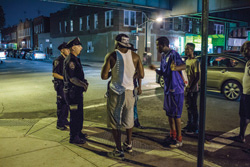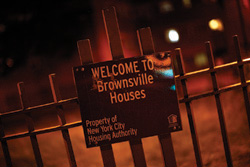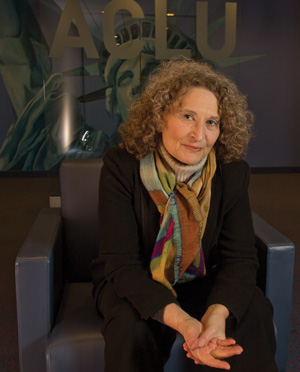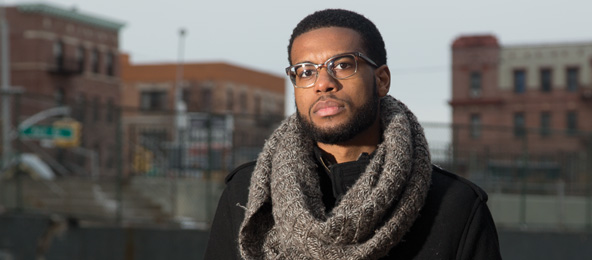Has 'stop and frisk' been stopped?

Though many New Yorkers credited aggressive police tactics for a sharp reduction in street crime, policies like stop-and-frisk proved immensely unpopular in the city’s poorest precincts. In one eight-block area of Brooklyn, police made nearly 52,000 stops over a four-year period, resulting in a limited number of arrests. ©Kevin Downs/Demotix/Corbis
In the new, gentrified post-9/11 New York City, gone are the days when a visitor’s trip to Times Square might include aggressive panhandling, a mugging or an uncomfortable exchange with a prostitute. But gone, too, are $900 apartments in the East Village, Soho artists lofts that artists can actually afford and $150-a-night hotel rooms that have their own bathroom.
In one of the signature achievements of Michael Bloomberg’s three terms as mayor, New York police helped create a new quality of life for many New Yorkers—even the poorest—through a sometimes merciless attention to low-level crimes like public intoxication, littering, graffiti, loitering and petty property crimes.
The policy grew from a statistics-driven program adopted in 1994 called CompStat, and was propelled by a crack-fueled crime surge that threatened to undermine the city’s reputation as the global epicenter of social democracy and cultural tolerance. By focusing on offenses that were offensive at the neighborhood level, police helped disperse concentrations of criminal behavior that were breeding more serious and more violent crimes.
By almost any standard, CompStat has been successful. Since 1990, murders have dropped 85.2 percent, rapes by more than half. Burglaries are down 85.7 percent and robberies are down 80 percent. Statisticians and criminologists are sometimes divided in their perceptions of the turnaround—citing changing demographics, stiffened sentencing, even the social effects of gentrification—but nearly all concede that CompStat’s concentrated enforcement policies have played a significant role.
And for the most part, these police tools have been acceptable to a broad swath of New Yorkers. One exception, however, has been the sticky business of “stop and frisk,” a proactive police tactic that grants broad law enforcement discretion to stop and search anyone suspected of intending to commit a crime. Though police have long had the right to search for weapons, even during such minor and temporary detentions as traffic stops, New York City police had expanded their use of those searches so broadly that their tactics became the subject of high-profile litigation and were a central issue during last year’s mayoral campaign.
During the campaign, Bill de Blasio argued that the city had strained race relations through its overzealous enforcement tactics. A vocal critic of the New York Police Department’s stop-and-frisk practices, the newly elected mayor announced in January that the city would drop its appeal of a federal court ruling that found the city’s practices were unconstitutional under the Fourth and 14th amendments. Evidence at trial revealed that the NYPD had an unwritten policy of targeting those deemed suspicious. In practice, that meant young blacks and Latinos were stopped and searched for weapons and contraband, often on pretexts that were flimsy or nonexistent.

©James Leynse/Corbis
The mayor announced a proposed settlement at Brooklyn’s Brownsville Recreation Center. The park department building is in an eight-block section of Brooklyn where, according to a New York Times report, nearly 52,000 police stops were made between January 2006 and March 2010.
Said de Blasio: “We believe in our obligation, the most fundamental one that there is in government, to keep people safe. And the values and the strategies that keep people safe … those values are not compatible with a broken and misused stop-and-frisk policy.”
Under the proposed settlement agreement in Floyd v. City of New York, the city agreed to drop its objections to findings by U.S. District Judge Shira Scheindlin. The agreement, which addresses Floyd and another similar case, Ligon v. City of New York, recognizes a federal monitor appointed by the judge, and includes such safeguards as the use of on-body cameras to monitor police stops.
“To us it’s a total victory,” says Jonathan Moore, a Floyd plaintiffs lawyer and a partner at New York’s Beldock Levine & Hoffman.
Well, maybe.

Jonathan Moore is a plaintiffs lawyer in the Floyd case. Photo by Arnold Adler.
TAINTED STOPS
Police unions filed a motion in November to intervene in Floyd, arguing that Scheindlin’s appointment of a federal monitor, along with other remedies listed in her August 2013 order, would impair officers’ abilities to do their jobs and harm their collective bargaining rights.
The police motion states that the Floyd opinion unfairly taints officers by stating that bad stops are widespread in the department.
On Feb. 7, the police unions filed in opposition to the city’s motion to remand Floyd and Ligon back to the district court for settlement. The filing asks the New York-based 2nd U.S. Circuit Court of Appeals to allow the police unions to continue to appeal the consent decree as intervenors. The motion says officers’ “daily work lives would be changed substantially” if key findings from Scheindlin’s orders are included in the consent decree. If the settlement goes forward anyway, the unions are asking that Scheindlin’s liability findings in Floyd be vacated.
On Feb. 21, the 2nd Circuit granted the city’s motion for limited remand back to the U.S. District Court for the Southern District of New York. The panel decided not to take a position on the intervenors’ motion, noting that the request would be better handled by the district court. “In the circumstances presented here, we believe it preferable that the motions be addressed there in the first instance, particularly because the appropriateness of intervention and the form it takes could well bear on settlement negotiations,” the ruling reads. “Moreover, the district court is better positioned to deal with the complexities that might arise during multifaceted settlement negotiations in which a variety of interests must be accommodated.”
“It ain’t over ’til it’s over,” says Burt Neuborne, a New York University law professor and founding legal director of the school’s Brennan Center for Justice.
In November, Neuborne filed a motion requesting that the appeals court allow a challenge to the removal of Scheindlin from the Floyd and Ligon cases. A panel of the court said Scheindlin’s conduct at a related hearing, as well as comments made to the media, suggested that her impartiality “may reasonably be questioned.” (See “No Longer the Case.”)
On Nov. 25, the appellate court issued an order of abeyance on the various Floyd motions, which froze all proceedings until de Blasio took office on Jan. 1.
Floyd is one of three class actions that allege the New York Police Department’s stop-and-frisk policies are unconstitutional. Under a Southern District of New York rule, it is considered a related case to Daniels v. City of New York, a 1999 class action brought by Moore and several other lawyers, as well as the New York-based Center for Constitutional Rights. The case, which settled in 2003, was the first class action to challenge New York’s stop-and-frisk policies.
The settlement agreement required the police department to document all stops and frisks, and the information was to be periodically given to plaintiffs counsel for monitoring purposes.
According to Moore, a review of the data showed an “alarming increase, year after year” in the number of police stops made. That raised concern that the increase in stops was a result of continued racial profiling by police. The findings led, in part, to the filing of Floyd in 2008.
According to the Floyd liability order, in 2011 and 2012 blacks and Hispanics represented 87 percent of all people stopped by New York City police. The order noted that 90 percent of those stopped were released without police finding any basis for a summons or arrest.
“To proceed from a stop to a frisk, the police officer must reasonably suspect that the person stopped is armed and dangerous,” the remedies order states.
“The purpose of a frisk is not to discover evidence of crime but to allow the officer to pursue his investigation without fear of violence.”
Credit for bringing crime down is often given to Mayor Bloomberg and his predecessor, Rudy Giuliani, both of whom touted a zero-tolerance approach to crime.
“It’s uncontested that New York City has seen a tremendous drop in crime,” says Steven Engel, who represents four of the five police unions involved in the litigation.
“Eighty-three percent of the suspects reported by crime victims were black and Hispanic,” adds Engel, a Dechert litigation partner who practices in the firm’s New York and Washington, D.C., offices. “There’s a close correlation between the demographics of the people the officers have stopped and the persons having been reported as having committed crimes.”
One of de Blasio’s first political appointees was Bill Bratton as police commissioner. Bratton previously served as police chief during the first three years of Giuliani’s administration. He replaced Ray Kelly, who oversaw a dramatic increase in the city’s stop-and-frisk practices, as stops rose from roughly 97,000 in 2002 to 685,000 in 2011.
While speaking with reporters at a December press conference, Bratton discussed bringing the police and the public “together in a collaboration of mutual respect and mutual trust.”
“I will get it right again in New York City,” he said.
Bratton told reporters in January that the problems with stop-and-frisk in New York City had “more or less been solved,” noting that there had been a 60 percent decrease in stops from 2012 to 2013.
Robin Steinberg is executive director of the Bronx Defenders, a nonprofit group that provides legal assistance to the indigent. She is hopeful about the proposed Floyd settlement agreement, but she says she finds it hard to believe the culture of the New York Police Department would suddenly have changed as much as Bratton might suggest.
In January, Steinberg notes, “11 young men were unlawfully stopped and frisked against the walls of the Bronx Defenders while one of our investigators recorded it on his phone. No contraband or weapons were found on anyone, and no arrests were made. It looked like stop-and-frisk as usual.”
Some have wondered whether New York City crime rates will shoot back up as police cut back on their stop-and-frisk practices to honor the settlement agreement. Steinberg doubts that will happen. She notes that as police stop-and-frisks declined over the past year, crime rates also continued to drop.
“History shows that crime rates are cyclical. Social scientists debate the reasons why, but no one has the answer. So at some point, no matter what policing strategies you have in place, crime rates will likely rise. Hopefully, it won’t be on the watch of a new, progressive mayor who is trying to make important and thoughtful reforms to policing in New York City,” she says.
“It’s easy to talk about equality and fairness now; the challenge is to hold on to those values when you don’t feel safe,” Steinberg adds. “That’s the real, true test of your commitment to fairness.”

Donna Lieberman of the New York Civil Liberties Union. Photo by Arnold Adler.
A BRONX TALE
David Floyd, a black medical student, is one of the named plaintiffs in the Floyd case. The liability order notes that he was stopped by police twice—once in 2007, while he was walking home, and another time in 2008. Both stops were in the Bronx, where Floyd lived. At the time of the second stop, Floyd was helping a neighbor, who had forgotten his key, get into an apartment in a building Floyd’s godmother owned.
Police testified that they stopped the men because they suspected a burglary, and that the two were observed in an area that had a history of burglaries.
Scheindlin found that those two stops were constitutional, but going through Floyd’s pockets during the frisk at his godmother’s property may have amounted to an unconstitutional search, as there was no allegation that officers noticed anything during the frisk that felt like a weapon or contraband.
Scheindlin ruled in August 2011 on the city’s summary judgment motion. She found that the city was not entitled to summary judgment on class claims of racial profiling, but she did grant the motion in regard to Floyd’s individual claims. She later reinstated one of his claims, about an illegal stop.
“In their zeal to defend a policy that they believe to be effective, they have willfully ignored overwhelming proof that the policy of targeting ‘the right people’ is racially discriminatory and therefore violates the United States Constitution,” Scheindlin’s liability order states.
“We need an end to the kind of philosophy of policing that says it’s OK to engage in preventive, detentionlike tactics,” says Donna Lieberman, executive director of the New York Civil Liberties Union.
Her organization represents the plaintiffs in the Ligon case. The complaint challenges the city’s Trespass Affidavit Program, through which police patrolled private Bronx apartment buildings and often made stops and trespass arrests.
Police defended the program as a crime-fighting tool. But in January 2013, Scheindlin found that police arrest practices associated with the program were unconstitutional because officers repeatedly stopped individuals outside buildings without reasonable suspicion of trespassing.
Lieberman mentions Floyd trial evidence from Eric Adams, a former NYPD officer who now serves as Brooklyn’s borough president. Adams testified that former commissioner Kelly told him in 2010 that officers targeted young black and Latino men. The reason, Kelly said, was because police wanted the men to fear that “every time they leave their home, they could be stopped by the police.”
Kelly has denied Adams’ sworn statement, but Lieberman thinks it is significant. “That’s another way of saying that people should worry about their freedom to walk the streets when they are not engaged in suspicious behavior,” Lieberman says, “and that is not OK.”
If someone feels they’ve been mistreated by police, they can file a report with the Civilian Complaint Review Board. The board is an independent city agency, and under the terms of an agreement reached in April 2012, its lawyers act as prosecutors when board members recommend the most serious level of discipline.
Since 2005, 25 to 30 percent of all complaints filed with the CCRB have been tied to stop-and-frisk.
In cases in which the board feels discipline is needed, members make a recommendation to the police commissioner, who makes the final decision. Before the 2012 agreement, the agency gave its findings to the police department and police department lawyers presented the cases to administrative judges. The CCRB prosecuted its first wrongful-stop-and-frisk case in December.
“Historically, the discipline that’s been imposed has ranged from one slap on the wrist to two,” Lieberman says. “There really hasn’t been any kind of punishment. And in terms of restorative practices, there hasn’t been the response of providing training for individuals who are engaging in wrongdoing.”
CONSTITUTIONAL GROUNDING
It may be time for the Supreme Court to revisit stop-and-frisk law, says lawyer and former U.S. Rep. Louis Stokes. “Police don’t budge; you have to move them,” he says. “It’s going to take legislation or a U.S. Supreme Court decision to move them where they have to be.”
Stokes represented John Terry and Richard Chilton in Terry v. Ohio, the landmark 1968 Supreme Court case that found police may search someone if they have a reasonable suspicion that the individual might be “armed and dangerous,” regardless of whether the officer has probable cause for an arrest.
Terry and Chilton were both black, and a detective found that each was carrying a gun. According to the opinion, the defendants attracted Detective Martin McFadden’s attention when they repeatedly walked alongside a downtown Cleveland store and looked in its windows. The two talked to a third man who was white, identified as Carl Katz, according to a 1964 transcript from an evidence-suppression motion hearing. McFadden approached the three, patted them down and felt weapons on Terry and Chilton. They were arrested, and Katz was allowed to leave.
The Supreme Court opinion did not mention the defendants’ or Katz’s race, but Stokes thinks that the detective stopped the three because it was unusual then to see blacks speaking with whites who were not authority figures.
“As a black man, I knew that black men at that time all over America were stopped indiscriminately on the streets, simply because they were black,” Stokes says. “They’d frisk you, find nothing, and then you were told to get on down the street. That happened all day and all night.”
At the evidence hearing, Stokes asked McFadden why he stopped the men. “I didn’t like them” was McFadden’s answer. Stokes thought that answer might have been enough to convince the judge it was a bad stop, and that the evidence-suppression motion might be granted based on that. When asked about questioning the detective specifically about whether race was his motive for the stop, Stokes says he “didn’t push it. I knew it would be too heavy to try and carry to the Supreme Court.”
The hearing took place a few years after Mapp v. Ohio, the 1961 Supreme Court opinion that found evidence from unreasonable searches and seizures was inadmissible in state court. “I used strictly the Fourth Amendment, thinking that was enough,” Stokes says.
The suppression motion was denied, and the defendants were convicted of carrying concealed weapons. Ultimately, the Supreme Court found that the search was reasonable under the Fourth Amendment. Chief Justice Earl Warren, writing for the majority, did note that minority groups “frequently complain” about police harassment, but those complaints would not be stopped by excluding evidence from a criminal trial.
“Under our decision, courts still retain their traditional responsibility to guard against police conduct which is overbearing or harassing,” the opinion stated.
FOR THE RECORD
Various states now have laws that require recording data, including race and ethnicity, for all traffic stops; and a handful of large city police departments, including New York and Philadelphia, require similar data for stop-and-frisks, says University of Pittsburgh law professor David Harris, whose academic work focuses on racial profiling.
A few states, including New Jersey and Washington, prohibit racial profiling or discrimination in policing under their own state law, Harris adds.
In 2003, the Justice Department issued policy guidance that forbids federal law enforcement from engaging in racial profiling. Harris notes that there’s an exemption for national security and immigration, which “of course are the two areas in which federal agencies are most likely to engage in profiling.”

The NYC Patrolmen’s Benevolent Association’s Pat Lynch. Photo by Arnold Adler.
RACE MATTERS
Few if any courts have dismissed a criminal case based on a defendant stopped because of his or her race, according to Harris. He mentions Whren v. U.S., a 1996 Supreme Court case that involved a drug conviction stemming from a traffic stop. The court found that any traffic violation by a driver provides probable cause for a stop.
Pat Lynch, a police officer and president of the New York City Patrolmen’s Benevolent Association, says it’s not hard to follow the law set forth in Terry v. Ohio. “You have to be able to articulate what the suspect is doing that is suspicious,” says Lynch, who spoke with the ABA Journal last fall. “For instance, when you have a person who is carrying a weapon, they tend to be heavy on one side. They’re nervous and repeatedly tap the area.”
The bigger problem, according to Lynch, is the goal that management sets for officers regarding stops and summonses. “If you don’t meet that goal, you get punished,” Lynch says. “I see police officers getting into trouble because they are trying to stay out of trouble.”
According to Lynch, punishments include assignment to a different shift, denial of opportunities to work overtime and unsatisfactory performance evaluations, which prevent promotions and transfers.
“Performance goals,” the Floyd order states, made it clear that supervisors evaluate officers based on activity numbers, with a focus on summonses, stops and arrests.
Evidence presented during trial included recordings officers made during police roll calls, where they are directed to get more stops and summonses.
One lieutenant supervising officers in Brooklyn’s predominantly black Bedford-Stuyvesant neighborhood reminded them that they were “not working in Midtown Manhattan, where people are walking around smiling and happy. You’re working in Bed-Stuy, where everyone’s probably got a warrant.”
A Halloween 2008 Bedford-Stuyvesant roll call was also recorded and presented as evidence: “Tonight is zero tolerance. It’s New Year’s Eve all over again. Everybody goes. I don’t care. … They’re throwing dice? They all go, promote gambling. I don’t care. Let the DA discuss what they’re going to do tomorrow,” a deputy inspector said. “They got [bandanas] on and they’re running like nuts down the block, chasing people? Grab them. Fuck it. You’re preventing a robbery. … You know that and I know that.”
The order found such behavior from management a problem, but it also noted that police department performance goals tied to stops may be “appropriate, once an effective system for ensuring constitutionality is in place.”
That finding disappoints Lynch. “There’s no time for community policing because you’re constantly chasing numbers,” he says. “We want to stop criminals; we don’t want to stop working folks. We’ve never wanted to do that, but that’s what the quotas do.”
Jeff Hynes, a retired commander with the Phoenix Police Department who now does consultant work, blames politicians. According to him, the Floyd case is not surprising, given Giuliani and Bloomberg’s 20-year focus on lowering crime.
“When you enter politics, you get things like quotas and numbers—with unrealistic expectations,” Hynes says. “Like: ‘No one can stand on the street corner.’ Really? How am I supposed to enforce that, legally?”

Kamau Butcher of the Bronx Defenders. Photo by Arnold Adler.
‘GET THE NUMBERS RIGHT’
New York City has had some embarrassing summons stories, says John Eterno, a retired NYPD police captain who now teaches criminal justice at Molloy College on Long Island.
Eterno recalls seven men ticketed in 2010 for playing chess by themselves at a Manhattan playground that didn’t allow adults unless they were with children. Though the park’s built-in chess tables were separated from the play area by a fence, the men were ticketed anyway. Two of the seven challenged their summonses, and a judge threw them out.
“There’s this culture to get the numbers right, so the commanders look good at CompStat,” says Eterno.
Kamau Butcher, a policy organizer with the Bronx Defenders, regularly speaks with young people about police encounters and their legal rights. He’s met people who have never been stopped, as well as people who get stopped on a weekly basis.
“Sometimes it’s not adversarial; it’s more like: ‘You know the drill. Get up against the wall,’ ” says Butcher, who sees such stops as examples of how relations between police and “community folks” have deteriorated.
When speaking with youths, Butcher focuses on their “rights, realities and responsibilities.” They often tell Butcher they are too afraid to ask police if they can leave during stops. He doesn’t blame them.
“A kid is up against a wall, and he thinks, ‘The officers are not touching me, but they’re both bigger than me, and they have guns. I am just going to hope that they leave me alone.’ ”
Butcher recalls an account a teen shared at a Hunts Point session.
“He said that he knew everything he was supposed to do during a stop, and he tried to do it,” Butcher recalls. “The police officer laughed at him and said he watched too much TV. Then the officer proceeded with the search and threw him up against a car.”
Sidebar
No Longer the Case
Judges should avoid the appearance of impropriety, the U.S. Judges Code of Conduct states. And U.S. District Judge Shira Scheindlin did not, according to the 2nd U.S. Circuit Court of Appeals at New York City. In October, an appellate panel removed Scheindlin from Floyd v. City of New York and Ligon v. City of New York, two of the four class actions she has presided over that challenge police stop-and-frisk policies. A longer ruling was issued in November.
No party asked for her removal; the panel made the decision on its own. The ruling noted that three media interviews Judge Scheindlin gave last year may have led some to conclude that she favored stop-and-frisk plaintiffs. It also mentions the Southern District of New York’s related-cases rule, which permitted transferring new, related civil cases to the same judge, instead of traditional random assignment.
Floyd and Ligon came to Scheindlin by way of Daniels v. City of New York, a 1999 class action challenging police stop-and-frisk policies. The case settled in 2003, but it was a December 2007 hearing about the consent decree that figured prominently in the 2nd Circuit panel’s decision regarding Scheindlin.
According to the appellate ruling, Scheindlin had addressed parties battling over compliance with the Daniels settlement. “And if you got proof of inappropriate racial profiling in a good constitutional case, why don’t you bring a lawsuit,” she said. “You can certainly mark it as related.”
After Scheindlin was removed from the cases, Burt Neuborne, a New York University law professor, filed a motion to appear on her behalf, urging the 2nd Circuit to reconsider the removal en banc.
Scheindlin’s 2007 statement, he says, does not make the judge appear to be biased toward the plaintiffs. Rather, she thought that litigation for enforcing the Daniels consent decree was a waste of time, when a new lawsuit could get to the merits more quickly.
“It’s clear what she was saying was ‘Spare us all six months of litigation,’ ” Neuborne says.
The 2nd Circuit’s longer decision, published Nov. 13, notes that Scheindlin did not specifically mention Floyd or Ligon in media interviews.
“While nothing prohibits a judge from giving an interview to the media, and while one who gives an interview cannot predict with certainty what the writer will say, judges who affiliate themselves with news stories by participating in interviews run the risk that the resulting stories may con-tribute to the appearance of partiality,” the ruling stated.
The 2nd Circuit, however, backed off its initial assertion that Scheindlin violated the related-cases rule. In December, the Southern District revised its related-cases rules, requiring parties seeking to mark a suit as related to another case to formally state how they are related. A judge’s decision to accept a case as related is now subject to review by the district’s three-judge assignment committee.
“I think it’s a pretty good idea to change the rule, so there’s never any question of impropriety,” Neuborne says.
This article originally appeared in the March 2014 issue of the ABA Journal with this headline: “Stopping stop and frisk: New York City crime has been dropping for decades, but who has been paying the price?”



